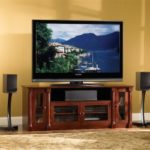Making a TV antenna with your own hands
Despite the huge number of television antennas on the consumer market, which can be easily purchased at any electronics store, interest in how to make an antenna for a TV with your own hands, does not disappear. This interest can be explained by the reluctance to spend money on the purchase of the antenna, being away from outlets (if you are in the outback or in the country) or failure of the purchased one.
Content
Types of TV antennas
Antennas for TV sets can be divided into several types.
- Full wave antenna - the design is easy to manufacture, can be made from simple scrap materials.Good enough to catch a digital signal outside the city, where there is not much interference. When located near a broadcast tower, it can receive analogue television.
- Log Periodic Antenna also easy to manufacture. It has perfect consistency with the feeder across all ranges, without changing the parameters in it. Since this design has average technical parameters, it can be used at the cottage, or as a room antenna in the city.
- Decimeter antenna. Often used a simplified modification of the Z-antenna, works well, regardless of the conditions of signal reception.
If you have multiple TVs in your home, then you should know How to connect to one antenna 2-3 television receivers.
Full wave antenna
All-wave TV signal catchers are also called frequency independent (ANV). Their designs may be different.
Two petals
The illustration shows a wave antenna made from two metal plates triangular in shape and two wooden slats on which fan-shaped copper wire is stretched.

Copper wire can take any diameter, it does not play a special role.The ends of the wire are mounted at a distance of 20 to 30 mm between them. Plates with welded to the other ends of the wire should be located at a distance of 10 mm from each other.
The metal plate can be replaced with a square piece of fiberglass, which has a copper foil on one side.
Since the design of a homemade antenna has a square shape, then its height will be equal to the width, and the angle between the canvases will be 90 degrees. Point of zero potential The picture is marked in yellow. Solder in this place the braid of the cable is not required - it will be enough tight tying.
A two-petal television signal receiver assembled in this way is capable of receiving all UHF meter and meter channels. Moreover, he is good at catching the signal in all directions. But if you install the BHA in a zone of poor signal reception from the TV tower, it will only work normally. with amplifier. You can apply other bad signal amplification techniques.
Butterfly shaped
Do-it-yourself can make a TV antenna in the shape of a butterfly. To make this very powerful antenna yourself, you need to prepare a plank or plywood with dimensions of 550 x 70 x 5 mm,a wire with a copper conductor section of 4 mm, and, respectively, a cable PK75.

Next, complete the following steps.
- Mark out the plywood space under the holes and drill them. Dimensions in the figure are in inches. Below the figure is a table for converting inches to mm.
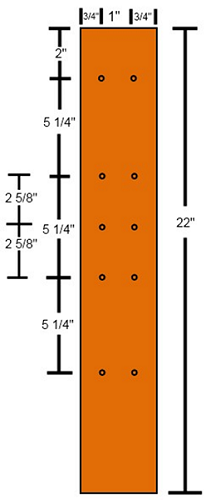
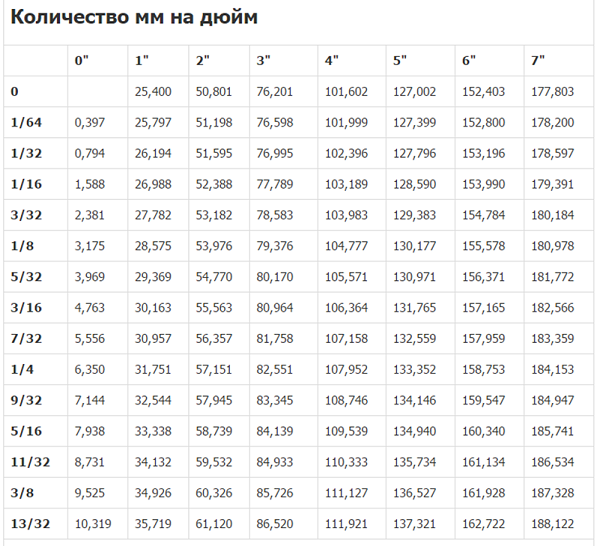
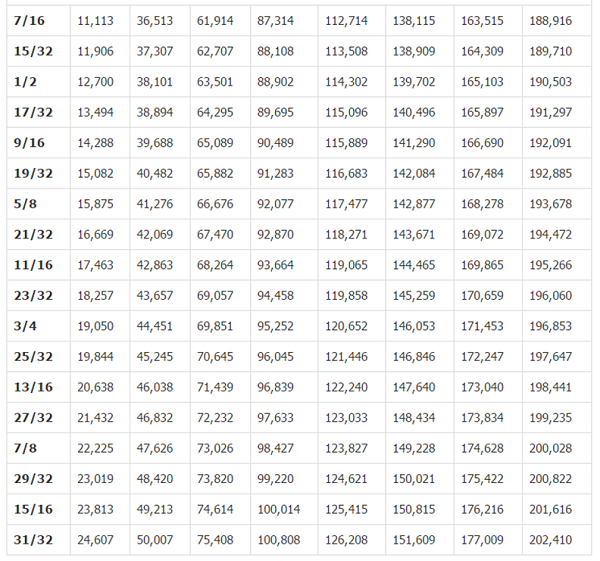
- 8 pieces of the same length of 37.5 cm should be cut from the copper wire.
- In the center of each wire, clean the areas of isolation (2 cm), as in the figure.
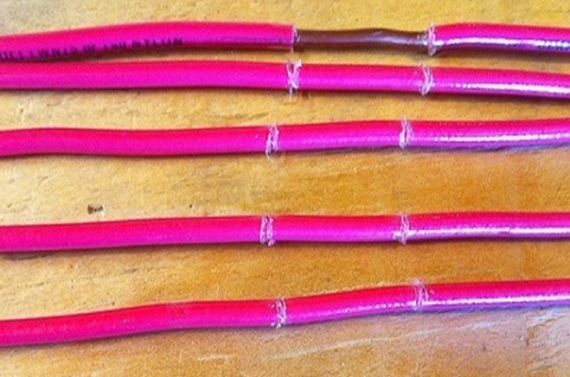
- After that, another 2 pieces of wire should be cut, already 22 centimeters each, divided into 3 equal parts and stripped of insulation in places of separation.
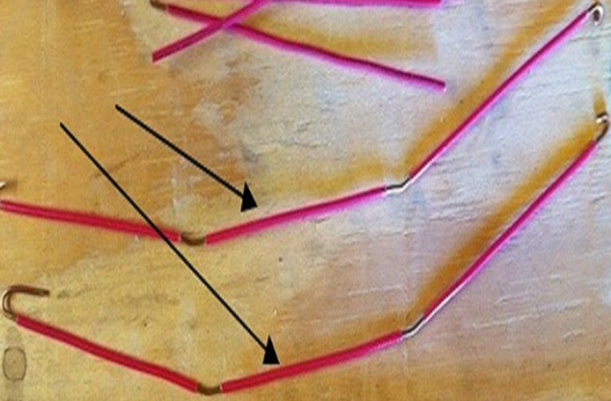
- Give segments V-shaped. Care should be taken to maintain a distance of 7.5 cm between the ends of the wire. It is this that is optimal to receive a clear signal.
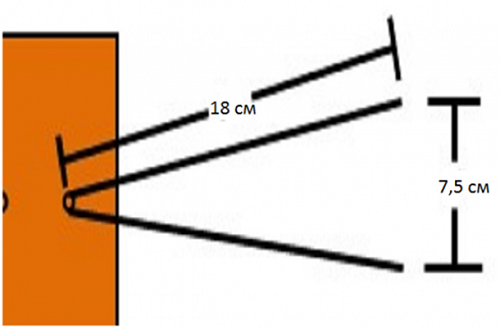
- Connect all the elements as shown below.
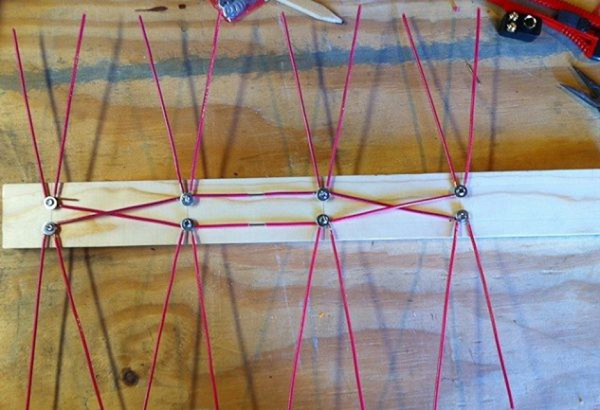
- Next you need to purchase a jack for connecting a plug to it.
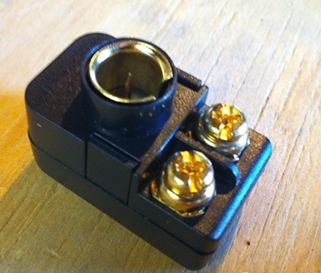
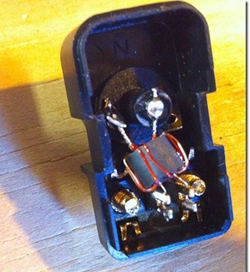
- The cable must be soldered to the contacts of the coil, as shown.
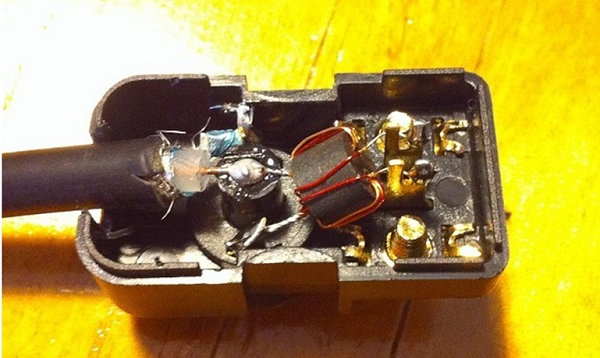
- Make another 2 pieces of wire of the required length to connect the antennae to the socket.
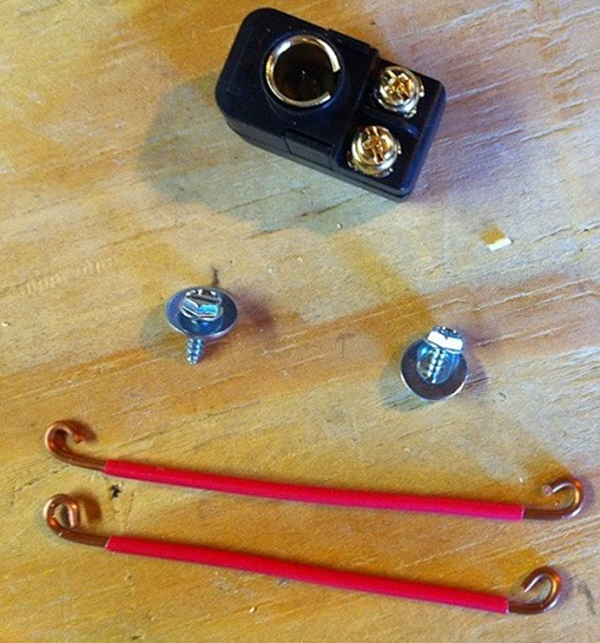
- Screw the nest onto the plate and connect all the elements.
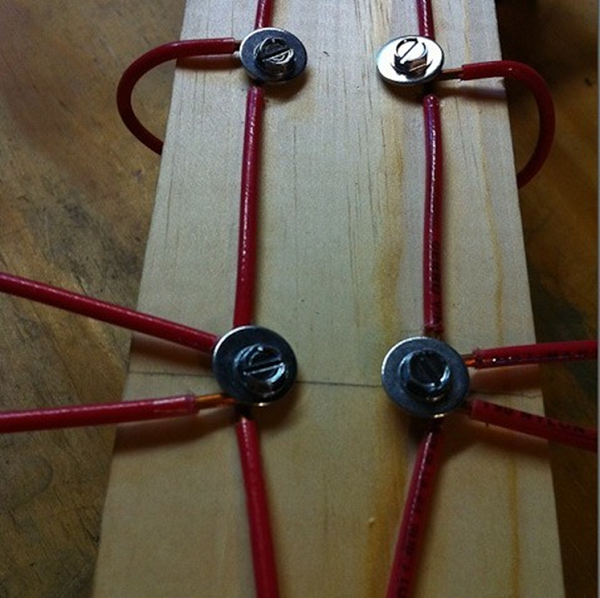
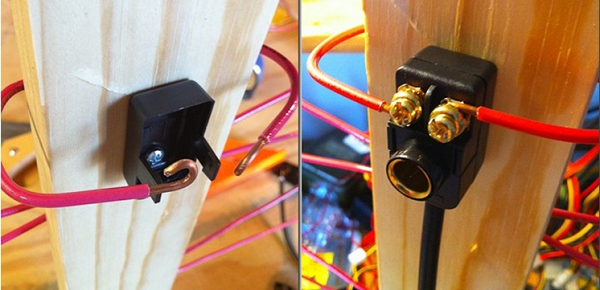
That's all - you made an antenna for the TV with your own hands.
Beer cans
For the manufacture of such an original private sector, you will need 2 cans (0.5 liters or 0.75) from a beer or other beverage. But before you make a television antenna, you need to consider some material requirements. Namely, it is recommended to purchase a high-quality TV cable having a resistance of 1 meter 75 Ohms. How to choose cable? Pay attention to the fact that the central core was strong, and the braid was double and solid.
Do not forget, the longer the cable is, the stronger the signal will be damped, which is especially important for receiving meter waves, unlike UHF, for which the length of the wire also matters, but not so much.
It will also be necessary to prepare the usual wooden trempel, a pair of screws, electrical tape or tape and, if possible, a soldering iron with tin.
- To make a homemade antenna, you must first prepare the cable. To do this, measure from its end 10 cm and make an incision. After that, clean the insulation from a small area to get to the insulation screen, which must be twisted in one turn.
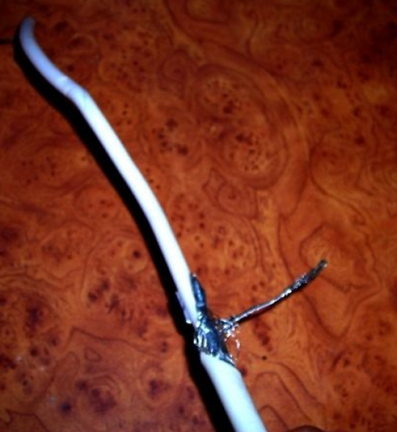
- Then, at the same end of the wire, clean the inner copper conductor from the insulation.
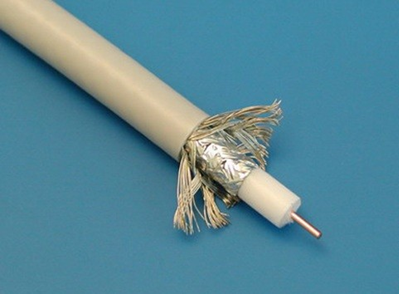
- At the other end of the cable connects the usual plug, which will be connected to the TV receiver.
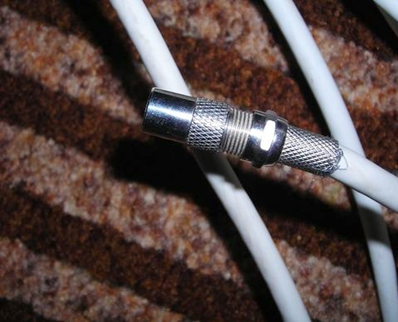
- The next step is to attach the contacts to the banks. With a screw, we attach a twisted screen to one bank, and the copper conductor to the other.
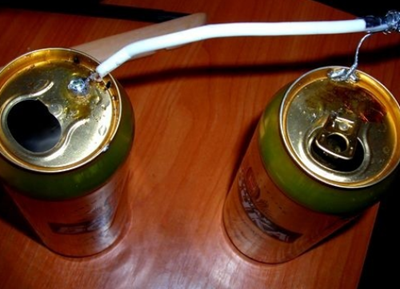
- After connecting the wires to the receiver signal, it is required to fasten on something. You can use the usual wooden plank, mop and stuff. In this case, trempel is used (it is easy to hang it in the right place). To fix the cans used electrical tape or tape. When fixing containers it is important to observe one rule: they must located on the same axis (on one line), otherwise the reception of the signal will be of poor quality. The distance between banks is recommended to do 75 mm, but you can experiment. It is better to have such a structure by the window.
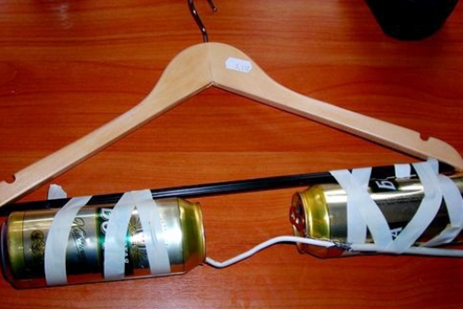
The antenna of beer cans can take both a decimeter wave band and meter.
For clarity, the whole process can be viewed. video.
Log periodic antenna
A log-periodic antenna (LPA) can be used to receive radio waves in both meter and decimeter ranges. For the manufacture of such a receiver signal can be used as a stand aluminum tube with a diameter of 10 mm and metal rods (studs), which can be bought in a store that sells fasteners. Ideally, instead of threaded rods, it is better to use smooth tubes or rods. A plastic U-shaped box is taken as the base.

Next, do the following.
- The tube must be flattened on one side for attachment to any support. Attach a plastic base to the second side.
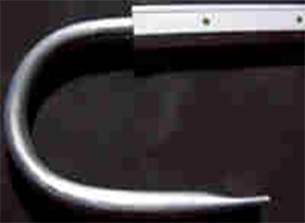
- Using the diagram below, make rods and drill holes in the box at the required distance from each other.
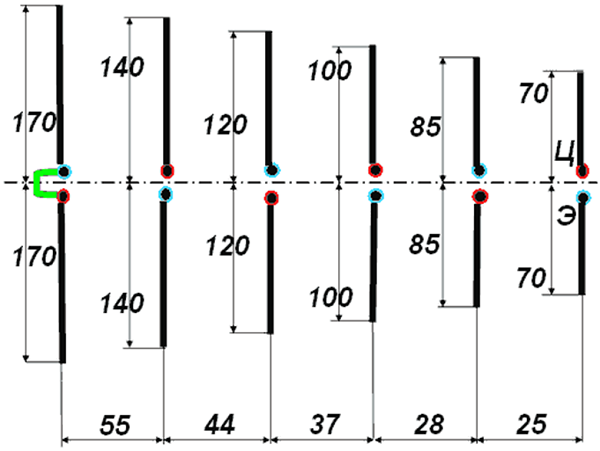
- Then you can assemble the entire structure. Insert the rod into the box and tighten the nut on one side. From the inner side of the rod, it is necessary to put the terminal (it is made of copper wire, in the form of a ringlet with a tail for subsequent soldering) and tighten the second nut.
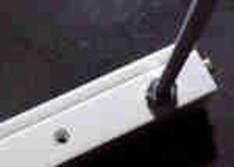
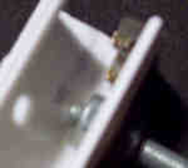
- After installing the rods in the box, they must be connected (soldered together). The soldering scheme is shown in the figure. Green in the figure shows the bracket (jumper) connecting the last elements. The cable to the TV is soldered to the right.
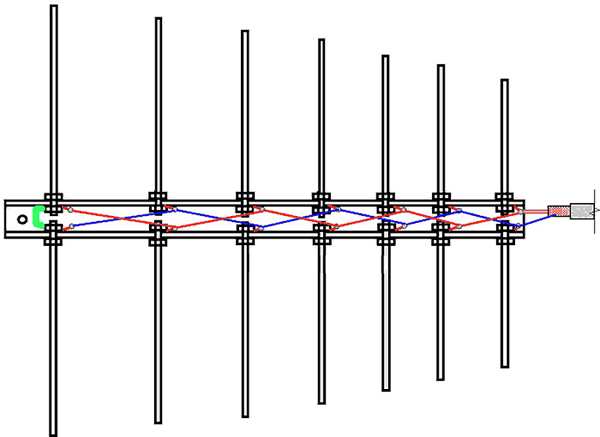
When the soldering is completed, the manufacture of the device can be considered complete and you can begin to test your creation.
Decimeter antenna
Self-made decimeter signal catchers can be of various shapes and designs, from the simplest to manufacture to more complex devices.
Ring-shaped
The simplest design for receiving UHF can be done in a short time with your own hands. from scrap materials. All you need is a coaxial cable and a piece of plywood of suitable size.
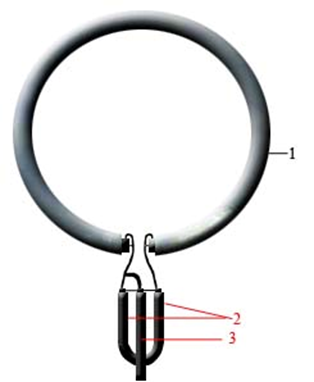
Now all this needs to be collected:
- prepare a length of coaxial cable (PK75) 530 mm long (a ring will be made from it);
- also cut another piece of cable with a length of 175 mm - this will be a loop;
- make a ring (1), solder to it a loop (2) and a cable (3) that connects to the TV;
- fasten all this on a plywood sheet and direct the made receiver of the television signal towards the TV tower.
If your television set using such an antenna does not catch the signalTry to make a more complex device.
In the form of eight
Homemade antenna UHF range with your own hands can be made of wire in the form of the figure 8.To make such a receiver, you can use copper or aluminum wire with a diameter of 3 to 5 mm, as well as the cable RK75. The manufacturing process will also need glue gun.
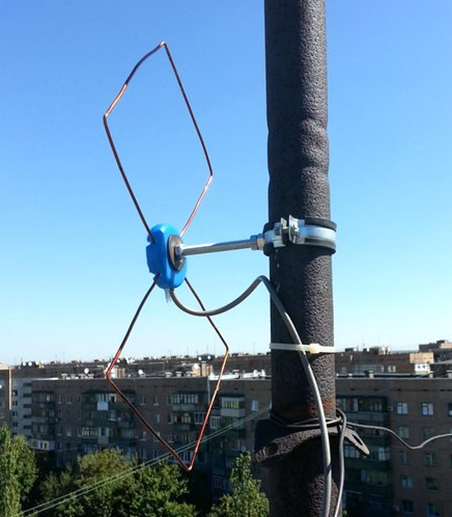
The course of production.
- Using wire cutters, you need to cut 2 pieces of wire of 56 cm each.
- At the ends of each segment make a loop, which should take 1 cm.
- Bend the squares from the wire and connect the loops. Solder the cable to the squares as shown in the figure. The central core is soldered to one square, braid to the other. The distance between the elements should be 2 cm. The entire structure can be fixed in the lid from under a 20 liter water bottle, filled with glue.
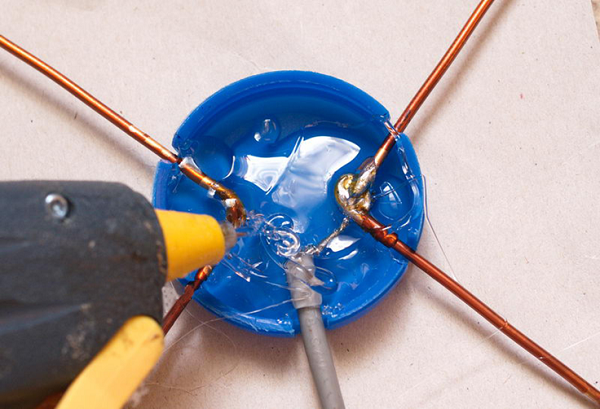
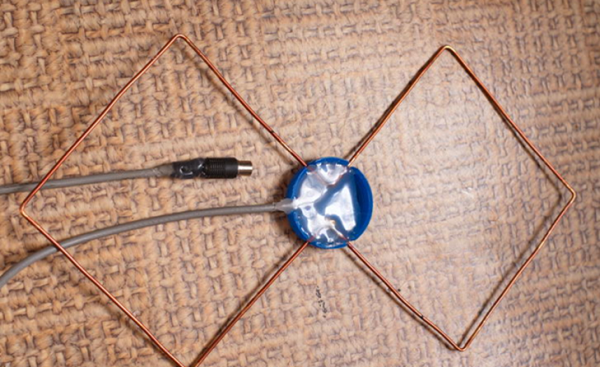
Such a receiver of the UHF range can be placed anywhere, and does not require an amplifier. Unless an amplifier can be needed if the device is external and the cable length is significant. In this case, to compensate for the loss of the signal, you will need to install it.
From a metalplastic pipe
Do-it-yourself TV antenna can be made from ordinary metal-plastic pipe. This will result in a device for receiving dmv with a possible range from 480 MHz to 1000 MHz.In this “model”, a pipe with a diameter of 16 mm and a cable of 5.5 m are used. A 55 cm pipe is required for the ring and 14 cm for the stand, which is equal to a quarter of the wavelength. This serves to better coordinate with the outer sheath of the cable and reduces in it high frequency currents.
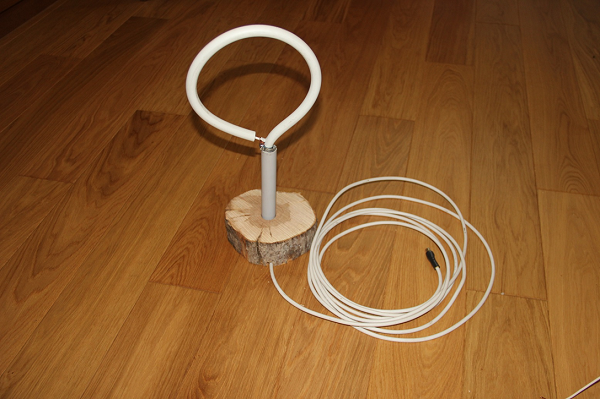
The cable exit in this construction is made through a hole in the pipe. The braid of the cable should be attached with a clamp to the bare part of the pipe. The central core of the cable is attached to the ring (you can use a screw with a washer and a nut). Such a homemade product works well as a room antenna in apartments with reinforced concrete walls, which are badly transmitted by a television wave. Thanks to the extended cable, it can be taken out on the balcony or put on the window sill - the reception quality will only improve.
In the form of a frame
Another design of the antenna dmv is assembled as a frame. It will be made of aluminum plates (lanes).
- First, you should assemble a frame of aluminum strips. They are attached overlap, using bolts and nuts. Fixing places to prevent corrosion is recommended to paint over paint.
- The cable should be soldered at points A and B, as seen in the figure.
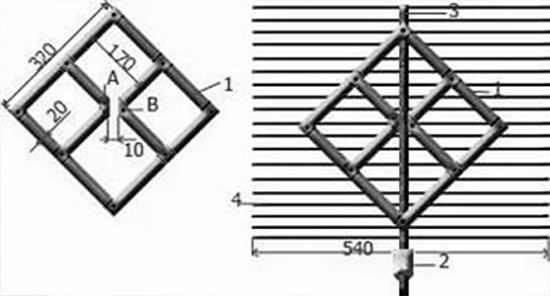
- Further, the square thus assembled is mounted on the mast, on which it is already fixed. reflector (reflector). As a reflector, you can use a reflector from an old Polish antenna, or use a grid for plaster.
- For better reception on the mast, install the amplifier and connect a coaxial cable to it (respectively, connect the frame with the amplifier).
Thus, self-made antennas will help you save money on their purchase, and in some cases get out of a situation where there is a TV, but the standard antenna has failed or there is none at all. Moreover, the reception quality homemade no worse than factory analogues. If you do not want to make the device yourself, then you will need information about which antenna is better to buy in the shop.

/rating_on.png)
/rating_half.png)
/rating_off.png)






